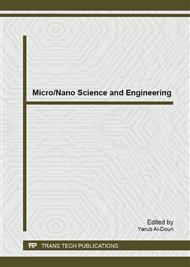[1]
Ajayan PM, Stephan O, Redlich Ph, Colliex C , Nature, 375(1995) 564–567.
Google Scholar
[2]
Feldman Y, Wasserman E, Srolovitz DJ, Tenne R, Science, 267(1995) 222–225.
Google Scholar
[3]
Jun YW, Lee SM, Kang NJ, Cheon JJ, J Am Chem Soc, 123(2001) 5150–5151.
Google Scholar
[4]
Huang MH, Mao S, Feick H, Yan H, Wu Y, Kind H, Webber E, Russo R, Yang P, Science 292(2001) 1897–1899.
DOI: 10.1126/science.1060367
Google Scholar
[5]
Satishkumar BC, Govindaraj A, Nath M, Rao CNR, J Mater Chem 10 (2000) 2115–2119.
Google Scholar
[6]
Murphy CJ, Jana NR, Adv Mater, 14 (2002) 80–82.
Google Scholar
[7]
El-Sayed MA, Acc Chem Res, 34 (2001) 257–264.
Google Scholar
[8]
Kottmann JP, Martin OJF, Smith DR, Schultz S, Chem Phys Lett, 341(2001) 1–6.
Google Scholar
[9]
Li L, Hu J, Yang W, Alivisatos AP, Nano Lett, 1(2001) 349–351.
Google Scholar
[10]
A.W. Xu, Y. Gao, H.Q. Liu, J. Catal. 207 (2002) 101.
Google Scholar
[11]
A.W. Xu, Y.P. Fang, L.P. You, H.Q. Liu, J. Am. Chem. Soc. 125 (2003) 1494.
Google Scholar
[12]
Y. Hasegawa, S. Thongchant, Y. Wada, H. Tanaka, T. Kawai, T. Sakata, H. Mori, S. Yanagida, Angew. Chem. Int. Ed. 41 (2002) (2073).
Google Scholar
[13]
J.W. Stouwdam, F.C. van Veggel, Nano Lett. 2 (2003) 733.
Google Scholar
[14]
M.S. Palmer, M. Neurock, M.M. Olken, J. Am. Chem. Soc. 124(2002) 8452.
Google Scholar
[15]
J.Y. Chen, P.R. Selvin, J. Am. Chem. Soc. 122 (2002) 657.
Google Scholar
[16]
A.H. Peruski, L.H. Johnson, L.F. Peruski, J. Immunol. Methods 263(2002) 35.
Google Scholar
[17]
Moon-Kyun Song, Shi-Woo Rhee, Thin Solid Films 492 (2005) 19 – 23.
Google Scholar
[18]
Yuan ZY, Zhang ZL, Du GH, Ren TZ, Su BL, Chem Phys Lett 378 (2003) 349–353.
Google Scholar
[19]
B. Zhaorigetu, Ga Ridi, Li Min, Journal of Alloys and Compounds 427 (2007) 235–237.
Google Scholar
[20]
B. Umesh, B. Eraiah, H. Nagabhushana, B.M. Nagabhushana, G. Nagaraja, C. Shivakumara, R.P.S. Chakradhar, Journal of Alloys and Compounds 509 (2011) 1146–1151.
DOI: 10.1016/j.jallcom.2010.09.143
Google Scholar
[21]
Lei SJ, Tang KB, Fang Z, Liu QC, Zheng HG, Mater Lett 60 (2006) 53–56.
Google Scholar
[22]
J.S. Kim, D.H. Reneker, Polym. Eng. Sci. 39 (1999) 849.
Google Scholar
[23]
J. Yu, J. Liu, M. Breedon, M. Shafiei, H. Wen, Y.X. Li, W. Wlodarski, G. Zhang, K. Kalantar-zadeh, J. Appl. Phys. 109 (2011) 114316.
DOI: 10.1063/1.3583658
Google Scholar


